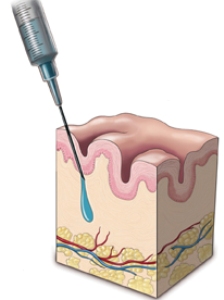Johns Hopkins researchers have created a new liquid material, a combination of synthetic and biological molecules, which might restore damaged soft tissue.
The composite material is infused under the human skin and it is set into a solid structure using light. The biomedical engineers expect that the material can be used to reform the soldier's faces affected by blast injuries in the future.
 PEG-HA is injected underneath the skin
PEG-HA is injected underneath the skin
The new material is developed from polyethylene glycol (PEG) and hyaluronic acid (HA). PEG is a synthetic molecule that is employed as surgical glue during operations and it does not cause severe immune reactions. HA is a natural ingredient found in the human skin that produces elasticity.
Biomedical engineers have injected various concentrations of HA and PEG into the back muscle and beneath the skin of rats. Followed by the injection, they applied a green LED light to set the material. Magnetic resonance imaging (MRI) was used to monitor the presence of the implant over time.
Johns Hopkins researchers examined the safety and persistence of the PEG-HA material by injecting it in three volunteers who were undergoing abdominoplasty. The examination was carried out for 12 weeks and the participants were infused with nearly five drops of HA alone or PEG-HA combination under the skin. The implant was observed using MRI and after 12 weeks it revealed that there was no loss of the implant size in the participants. Though the composite material shows promising application, it is not yet ready for clinical use. Thus, researchers have greater hope for the use of the new liquid material in people with facial injuries.